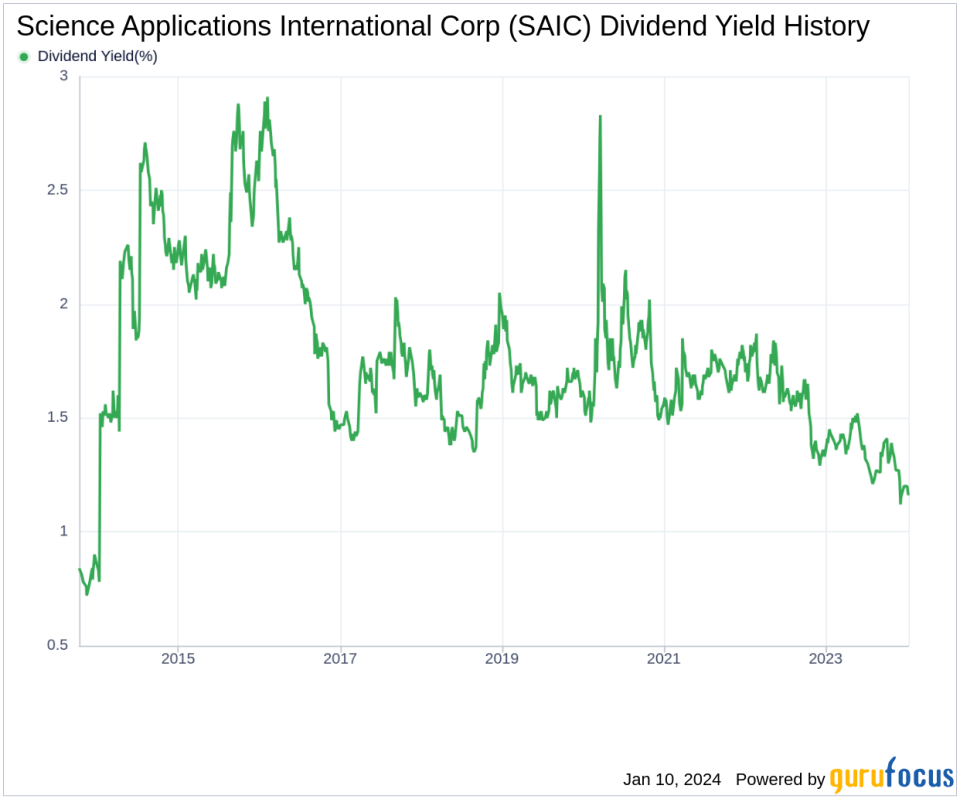Science Applications International Corp's Dividend Analysis
Assessing the Upcoming Dividend and Historical Performance of SAIC
Science Applications International Corp (NYSE:SAIC) recently announced a dividend of $0.37 per share, payable on 2024-01-26, with the ex-dividend date set for 2024-01-11. As investors look forward to this upcoming payment, the spotlight also shines on the company's dividend history, yield, and growth rates. Using the data from GuruFocus, let's look into Science Applications International Corp's dividend performance and assess its sustainability.
What Does Science Applications International Corp Do?
This Powerful Chart Made Peter Lynch 29% A Year For 13 Years
How to calculate the intrinsic value of a stock?
Science Applications International Corp provides technical, engineering, and enterprise IT services primarily to the U.S. government. Specifically, the company offers engineering, systems integration, and information technology for large government projects and a broad range of services with an emphasis on higher-end technology services. The company's end-to-end enterprise IT offerings span the entire spectrum of customers' IT infrastructure.
A Glimpse at Science Applications International Corp's Dividend History
Science Applications International Corp has maintained a consistent dividend payment record since 2013. Dividends are currently distributed on a quarterly basis. Furthermore, Science Applications International Corp has increased its dividend each year since 2014. The stock is thus listed as a dividend achiever, an honor that is given to companies that have increased their dividend each year for at least the past 10 years. Below is a chart showing annual Dividends Per Share for tracking historical trends.
Breaking Down Science Applications International Corp's Dividend Yield and Growth
As of today, Science Applications International Corp currently has a 12-month trailing dividend yield of 1.18% and a 12-month forward dividend yield of 1.18%. This suggests an expectation of the same dividend payments over the next 12 months. Extended to a five-year horizon, this rate increased to 4.10% per year. Based on Science Applications International Corp's dividend yield and five-year growth rate, the 5-year yield on cost of Science Applications International Corp stock as of today is approximately 1.44%.

The Sustainability Question: Payout Ratio and Profitability
To assess the sustainability of the dividend, one needs to evaluate the company's payout ratio. The dividend payout ratio provides insights into the portion of earnings the company distributes as dividends. A lower ratio suggests that the company retains a significant part of its earnings, thereby ensuring the availability of funds for future growth and unexpected downturns. As of 2023-10-31, Science Applications International Corp's dividend payout ratio is 0.16. Science Applications International Corp's profitability rank, offers an understanding of the company's earnings prowess relative to its peers. GuruFocus ranks Science Applications International Corp's profitability 8 out of 10 as of 2023-10-31, suggesting good profitability prospects. The company has reported positive net income for each of the year over the past decade, further solidifying its high profitability.
Growth Metrics: The Future Outlook
To ensure the sustainability of dividends, a company must have robust growth metrics. Science Applications International Corp's growth rank of 8 out of 10 suggests that the company's growth trajectory is good relative to its competitors. Revenue is the lifeblood of any company, and Science Applications International Corp's revenue per share, combined with the 3-year revenue growth rate, indicates a strong revenue model. Science Applications International Corp's revenue has increased by approximately 8.50% per year on average, a rate that outperforms approximately 50.02% of global competitors. The company's 3-year EPS growth rate showcases its capability to grow its earnings, a critical component for sustaining dividends in the long run. During the past three years, Science Applications International Corp's earnings increased by approximately 7.50% per year on average, a rate that outperforms approximately 46.53% of global competitors. Lastly, the company's 5-year EBITDA growth rate of 6.10%, which outperforms approximately 37.05% of global competitors.
Next Steps
Considering Science Applications International Corp's consistent dividend payments, commendable dividend growth rate, manageable payout ratio, strong profitability, and positive growth metrics, the company stands as a potentially attractive option for value investors focused on dividend income. The question remains: Can Science Applications International Corp maintain this trajectory and continue to reward shareholders with sustainable dividends? As the company navigates through the evolving landscape of government IT services, investors would do well to monitor these financial health indicators closely. GuruFocus Premium users can screen for high-dividend yield stocks using the High Dividend Yield Screener.
This article, generated by GuruFocus, is designed to provide general insights and is not tailored financial advice. Our commentary is rooted in historical data and analyst projections, utilizing an impartial methodology, and is not intended to serve as specific investment guidance. It does not formulate a recommendation to purchase or divest any stock and does not consider individual investment objectives or financial circumstances. Our objective is to deliver long-term, fundamental data-driven analysis. Be aware that our analysis might not incorporate the most recent, price-sensitive company announcements or qualitative information. GuruFocus holds no position in the stocks mentioned herein.
This article first appeared on GuruFocus.

